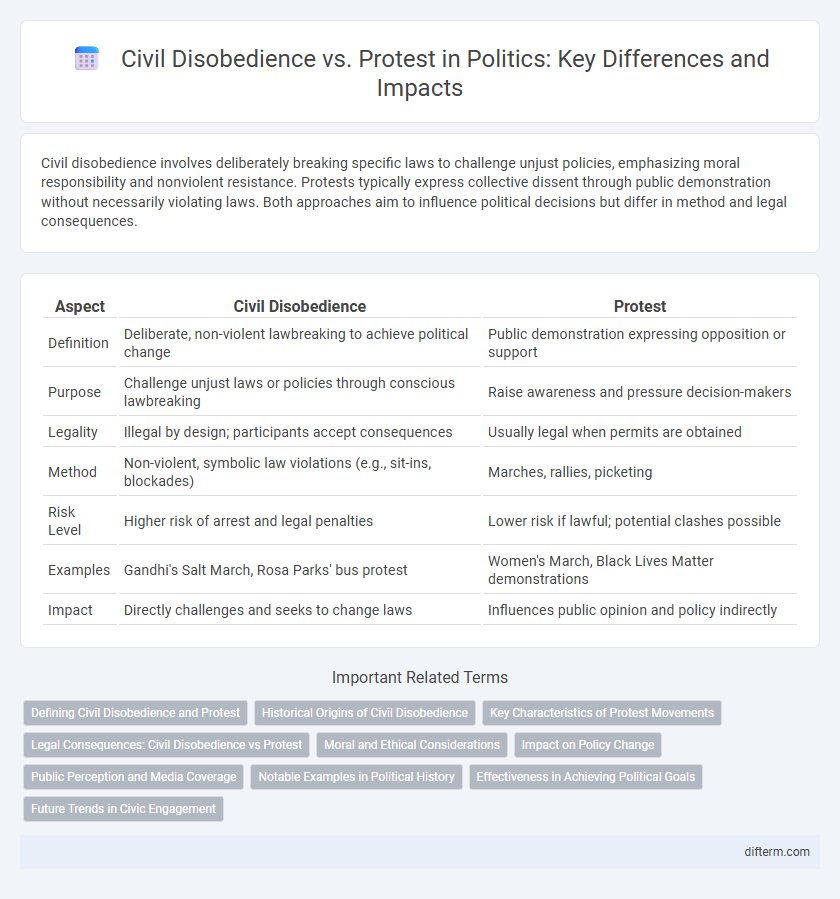Civil disobedience involves deliberately breaking specific laws to challenge unjust policies, emphasizing moral responsibility and nonviolent resistance. Protests typically express collective dissent through public demonstration without necessarily violating laws. Both approaches aim to influence political decisions but differ in method and legal consequences.
Table of Comparison
| Aspect | Civil Disobedience | Protest |
|---|---|---|
| Definition | Deliberate, non-violent lawbreaking to achieve political change | Public demonstration expressing opposition or support |
| Purpose | Challenge unjust laws or policies through conscious lawbreaking | Raise awareness and pressure decision-makers |
| Legality | Illegal by design; participants accept consequences | Usually legal when permits are obtained |
| Method | Non-violent, symbolic law violations (e.g., sit-ins, blockades) | Marches, rallies, picketing |
| Risk Level | Higher risk of arrest and legal penalties | Lower risk if lawful; potential clashes possible |
| Examples | Gandhi's Salt March, Rosa Parks' bus protest | Women's March, Black Lives Matter demonstrations |
| Impact | Directly challenges and seeks to change laws | Influences public opinion and policy indirectly |
Defining Civil Disobedience and Protest
Civil disobedience involves intentionally breaking specific laws to challenge governmental policies or social injustices while accepting legal consequences. Protest encompasses a broader range of public demonstrations, including rallies, marches, and sit-ins, aimed at expressing dissent without necessarily violating laws. Understanding the distinction lies in civil disobedience's deliberate legal transgression versus protest's lawful expression of political or social demands.
Historical Origins of Civil Disobedience
Civil disobedience traces its origins to philosophical and political figures like Henry David Thoreau, whose 1849 essay "Resistance to Civil Government" advocated for nonviolent resistance against unjust laws. This approach gained prominence during the Indian independence movement led by Mahatma Gandhi, who employed it strategically to challenge colonial rule through mass noncompliance. Unlike general protests, civil disobedience explicitly involves the deliberate violation of specific laws to highlight injustice and provoke legal and social change.
Key Characteristics of Protest Movements
Protest movements typically involve organized, collective actions aimed at expressing dissent or demanding social and political change through rallies, marches, and demonstrations. These movements emphasize visibility and public participation to influence policymakers and public opinion, often operating within legal boundaries. Key characteristics include nonviolent tactics, clear goals, leadership structures, and the mobilization of diverse groups to sustain momentum and media attention.
Legal Consequences: Civil Disobedience vs Protest
Civil disobedience often involves the intentional violation of laws to highlight injustice, exposing participants to legal consequences such as arrest, fines, or imprisonment. In contrast, protests typically occur within legal boundaries, minimizing the risk of legal penalties if permits are obtained and regulations followed. Understanding the legal implications is crucial for activists to navigate risks while advocating for change effectively.
Moral and Ethical Considerations
Civil disobedience involves deliberately breaking laws to highlight injustice, grounded in moral convictions that prioritize ethical principles over legal compliance. Protest, while often lawful, serves as a collective expression of dissent aimed at influencing public policy without necessarily violating legal norms. The ethical debate centers on whether the moral imperative to resist unjust laws justifies civil disobedience or if adherence to legal frameworks maintains societal order and legitimacy.
Impact on Policy Change
Civil disobedience often leads to more significant policy change by challenging legal norms and forcing lawmakers to address injustices directly. Protests can raise public awareness and mobilize communities but may not always result in immediate legislative action. The sustained moral pressure from civil disobedience campaigns tends to create deeper political shifts and reform.
Public Perception and Media Coverage
Civil disobedience often gains nuanced public perception due to its deliberate law-breaking to highlight injustice, which can elicit sympathy or condemnation depending on cultural and political contexts. Media coverage tends to frame civil disobedience with a focus on moral legitimacy and consequences, contrasting with protests that are frequently portrayed as mass expressions of dissent with varying degrees of disruption. This differential media framing significantly shapes public opinion, influencing whether civil disobedience is seen as a principled stance or a public order threat.
Notable Examples in Political History
Civil disobedience, exemplified by Mahatma Gandhi's Salt March in 1930, involves the deliberate violation of unjust laws to promote social change, distinguishing it from broader protest movements such as the 1963 March on Washington led by Martin Luther King Jr. The Montgomery Bus Boycott of 1955 also highlights civil disobedience aimed at dismantling segregation laws, whereas protests like the Vietnam War demonstrations of the 1960s mobilized mass public dissent without necessarily breaking laws. These pivotal moments underscore the strategic use of nonviolent resistance in shaping civil rights and political reforms.
Effectiveness in Achieving Political Goals
Civil disobedience often proves more effective in achieving political goals due to its nonviolent nature and willingness to accept legal consequences, which garners public sympathy and media attention. Protests can raise awareness quickly through mass participation but may struggle to sustain long-term political pressure without clear organization or strategic planning. Historical examples such as the Civil Rights Movement demonstrate civil disobedience's ability to enact lasting legislative change.
Future Trends in Civic Engagement
Future trends in civic engagement indicate a shift toward digital activism, where civil disobedience increasingly leverages online platforms to organize and amplify impact without physical confrontation. Protest movements are evolving with hybrid models combining virtual participation and selective in-person demonstrations to maximize safety and reach. Data shows younger generations prioritize sustainability and social justice, driving more creative, decentralized approaches to civic participation.
civil disobedience vs protest Infographic

 difterm.com
difterm.com